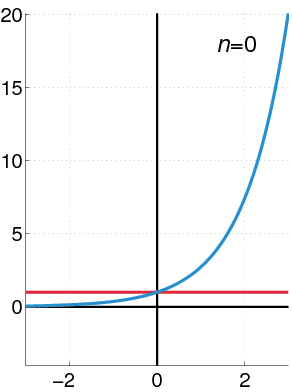| Description |
Illustration of the en:Exponential function |
| Source |
self-made with MATLAB. |
| Date |
Oleg Alexandrov 03:11, 30 August 2007 (UTC) |
| Author |
Oleg Alexandrov |
Permission
( Reusing this image) |
see below
|
|
|
I, the copyright holder of this work, hereby release it into the public domain. This applies worldwide.
In case this is not legally possible:
I grant anyone the right to use this work for any purpose, without any conditions, unless such conditions are required by law.
Afrikaans | Alemannisch | Aragonés | العربية | Asturianu | Български | Català | Cebuano | Česky | Cymraeg | Dansk | Deutsch | Eʋegbe | Ελληνικά | English | Español | Esperanto | Euskara | Estremeñu | فارسی | Français | Galego | 한국어 | हिन्दी | Hrvatski | Ido | Bahasa Indonesia | Íslenska | Italiano | עברית | Kurdî / كوردی | Latina | Lietuvių | Latviešu | Magyar | Македонски | Bahasa Melayu | Nederlands | Norsk (bokmål) | Norsk (nynorsk) | 日本語 | Polski | Português | Ripoarisch | Română | Русский | Shqip | Slovenčina | Slovenščina | Српски / Srpski | Suomi | Svenska | ไทย | Tagalog | Türkçe | Українська | Tiếng Việt | Walon | 中文(简体) | 中文(繁體) | zh-yue-hant | +/- |
MATLAB source code
% The exponential function as the sum of its Taylor series
function main()
% KSmrq's colors
red = [0.867 0.06 0.14];
blue = [0, 129, 205]/256;
green = [0, 200, 70]/256;
yellow = [254, 194, 0]/256;
white = 0.99*[1, 1, 1];
% Set up the grid and other parameters
N = 100;
A = -3; B = 3;
X = linspace(A, B, N);
Y = exp(X);
D = max(Y); C = -0.2*D;
% plot the frames
Sum = 0*X; Term = 0*X+1;
num_frames = 8;
for j=0:num_frames
Sum = Sum+Term;
Term = Term.*X/(j+1);
% Set up the figure
lw = 3; % linewidth
fs = 20; % font size
figure(1); clf; set(gca, 'fontsize', fs);
hold on; grid on;
set(gca, 'DataAspectRatio', [1 3 1]); % aspect ratio
plot_axes (A, B, C, D, lw/1.3);
plot(X, Sum, 'color', blue, 'linewidth', lw);
plot(X, Y, 'color', red, 'linewidth', lw);
axis([A, B, C, D]);
text_str = sprintf('{\\it n}=%d', j)
H= text (1.2, 18, text_str, 'fontsize', floor(1.2*fs))
frame=sprintf('Frame%d.eps', 1000+j);
disp(frame)
saveas(gcf, frame, 'psc2');
end
% Convert to animation with the command
% convert -antialias -loop 10000 -delay 100 -compress LZW Frame100* Exp_series.gif
function plot_axes (A, B, C, D, lw)
black = [0, 0, 0];
plot([A B], [0, 0], 'linewidth', lw, 'color', black);
plot([0, 0], [C, D], 'linewidth', lw, 'colour', black);
Click on a date/time to view the file as it appeared at that time.
The following pages on Schools Wikipedia link to this image (list may be incomplete):

